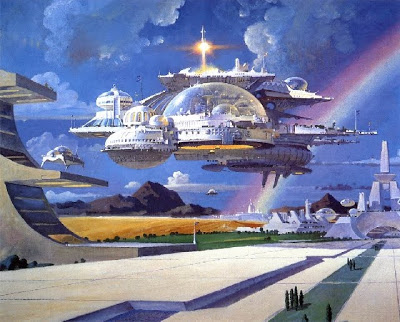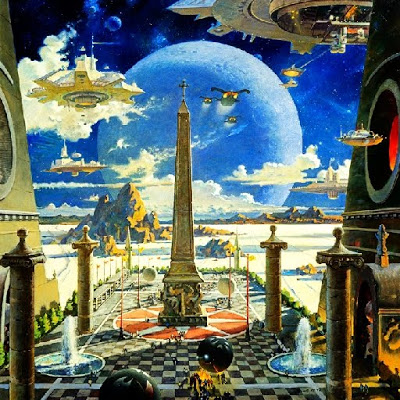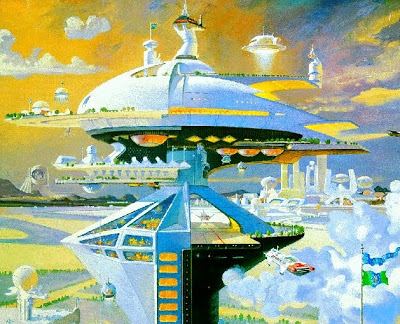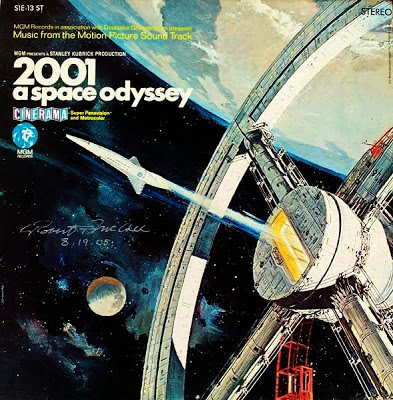Philosophy
 Robert T. McCall
Robert T. McCall
December 23rd, 1919 to February 26th, 2010
Robert T. McCall, an artist whose fervor for space exploration found expression in his six-story-tall mural at the National Air and Space Museum and two postage stamps canceled on the Moon, died on Feb. 26 in Scottsdale, Ariz. He was 90.
The cause was heart failure, his wife, Louise, said.
Mr. McCall eagerly translated his youthful enthusiasm for drawing knights in shining armor on spirited steeds into paintings of intrepid astronauts in gleaming space vehicles, both real and imagined. When NASA in 1962 hit on the idea of enlisting artists to promote its mission, Mr. McCall was one of the first three chosen.
He went on to create hundreds of vivid paintings, from representations of gleaming spaceships to futuristic dream cities where shopping centers float in space. His most famous image may be the gargantuan mural, showing events from the creation of the universe to men walking on the Moon, on the south lobby wall of the National Air and Space Museum on the National Mall in Washington. More than 10 million people a year pass it.
Or it might be his painting showing a space vehicle darting from the bay of a wheel-shaped space station, which was used in a poster for Stanley Kubrick’s landmark 1968 film, “2001: A Space Odyssey.”
Then there are the mission patches he made for astronauts, including one for the last men to walk on the Moon; the many paintings that hang in military buildings from the Pentagon to the Air Force Academy; and the enormous mural at the Johnson Space Center in Houston showing the progression of the American space program, from the first Mercury missions to the space shuttle.
He also designed more than a dozen stamps for the United States Postal Service, and a set was ceremoniously canceled on the lunar surface by David Scott, commander of the Apollo 15 mission.
H. Lester Cooke, former curator of painting at the National Gallery of Art, once noted that Mr. McCall had “the quality and scope of imagination to travel in space, and carry us along with him.” Isaac Asimov was widely quoted as calling Mr. McCall “the nearest thing we have to an artist in residence in outer space.”
Robert Theodore McCall was born in Columbus, Ohio, on Dec. 23, 1919. He grew up fascinated with airplanes and looking at Moon craters through a telescope, but the first painting he sold was of a dentist’s dog. He was paid $10 for it. He studied at an art school in Columbus and served in the Army Air Forces during World War II as a bombardier instructor.
He worked in Chicago and New York illustrating advertisements and magazine articles, including science fiction in pulp magazines. In 1957 he went to Cape Canaveral in Florida to paint at the request of the Air Force.
His freelance work for Life magazine on the future of space exploration captivated NASA, which was starting to hire artists to add flair and emotional depth to portrayals of its work.
The other two artists NASA first approached were Mitchell Jamieson, a well-known illustrator who had worked with the Navy, and Andrew Wyeth, whom a poll had designated “America’s most popular painter.” Mr. Jamieson accepted, but Mr. Wyeth ultimately declined.
As the program grew, more venturesome and abstract artists were added to the realists first commissioned, including Robert Rauschenberg. Other artists in the program included Andy Warhol, Norman Rockwell and the photographer Annie Leibovitz.
Though his illustrations of manned space flight include Alan Shepard’s first Mercury mission, Mr. McCall did not attend a launch until Gordon Cooper blasted off in May 1963. In an interview with Smithsonian magazine in 1984, Mr. McCall described the exquisite tension of riding an open-cage elevator to the space capsule with Cooper.
“You get in the habit of wanting these experiences,” he said, saying he imagined himself in Cooper’s shoes. Mr. McCall went on to witness more than 25 additional launches, including most trips to the Moon and most space shuttle missions.
In addition to his wife of 64 years, the former Louise Harrap, Mr. McCall is survived by their daughters, Linda and Catherine McCall; five grandchildren; and six great-grandchildren.
Mr. McCall’s great disappointment was that he never made it to space himself. When NASA began a program to take people from other professions on shuttle missions, he was on the list.
But after Christa McAuliffe, a teacher, died when the space shuttle Challenger exploded on Jan. 28, 1986, that program was ended.
Internationally noted artist Robert McCall died last Friday in Scottsdale, Ariz. The 90-year-old artist and Paradise Valley resident whose works are included in the University of Arizona Museum of Art, won decades of acclaim for his depiction of space and human space travel
As much as anyone outside the scientific community, McCall popularized the U.S. space program with his fanciful, and often prescient, scenes of astronauts, their spacecrafts and operations on other worlds beyond Earth.
His works include a six-story high mural covering a wall at the National Air and Space Museum in Washington, D.C. and the poster for the Oscar-winning 1968 Stanley Kubrick film, "2001: A Space Odyssey."
UAMA currently holds more than 200 of McCall's artwork, a sample of which were on exhibit for several months in 2008, coinciding with the UA-led NASA Phoenix Mars Mission.
Peter Wehinger, a staff astronomer and development officer at the UA Steward Observatory, said McCall followed in the footsteps of Chesley Bonestell, the artist whose work during the early and middle 20th century inspired science fiction and fueled public interest in space exploration.
Wehinger, a longtime friend of McCall and his wife, Louise, said McCall was a founding member of the astronomy board at Steward and helped fund a number of financially struggling students through the UA.
"About five or six years ago, he began to think about his work and we had many discussions about how and where they might go," Wehinger said. UAMA Director Charles Guerin, he said, gave McCall a warm and enthusiastic reception.
After several meetings at McCall's Paradise Valley studio they worked out an agreement to transfer the bulk of his work to UAMA. That included not only his paintings, but sketches, slides and even designs for the patches that NASA astronauts wore on their missions in space.
Guerin described McCall as a visionary as well as an exceptionally gifted artist.
"Bob was America's preeminent illustrator of the history of aviation, the NASA program and space flight in general. He had entree to some of the most remarkable aspects of American aviation history, including landing man on the Moon and the launch of the space shuttle.
"Much of his work was his interpretation of where we were going as a people. I don't even like to refer to it as science fiction. Bob saw the world in terms of what it would be and could be. He was an extraordinary individual."
Guerin said McCall's archives are a gift that "will allow young students to study his creative efforts, his remarkable artistic career."
McCall also spearheaded the creation of the Archive of Visual Arts at the museum. The Robert T. and Louise H. McCall Gallery at UAMA was named for the artist and his wife.
"He was the guy who would never stop working," said Wehinger. "When I visited him six months ago he had just completed a portrait of (Apollo 11 commander) Neil Armstrong for NASA and was starting on a painting for the U.S. Navy SEALS headquarters in Virginia."
"He had a marvelous way of describing things scientifically and looking to what might be next, and that takes a special talent in addition to making brush strokes of a painting," he said.





- End Of The Space Shuttles
I don't understand all the frowning faces when the shuttle Atlantis returns marking the end of the space shuttle program. Many act like it is the end of America...the end of the world. Come on, it is about time to realize that the United States is...
- Shuttle Atlantis--retired
"Shuttle Atlantis touches down for last time" by Marcia Dunn May 26th, 2010 Associated Press Space shuttle Atlantis is back on Earth, and its flying career is over. Atlantis and its six-man crew landed at Florida's Kennedy Space Center this morning....
- To The Moon And Beyond
"Men will return to the moon, but they will likely speak Chinese." This is a well-crafted article promoting political and cultural hype. It fosters the assumption that bias and non-cooperation would be the rule. Besides, where is it written that only...
- Nasa's Garage Sale
Have a few extra bucks? Get involved in NASA huge sale...and I mean huge. "NASA Garage Sale Includes Shuttles, Engines, Space Suits" by Jason Paur January 21st, 2010 Wired Looking for a good deal during the recession? Space geeks don’t have to...
- Apollo Astronauts Complain
I expected nothing less from "space cowboys". "Apollo astronauts bemoan state of U.S. space program" by Irene Klotz July 21st, 2009 Reuters CAPE CANAVERAL, Florida--The U.S. investment in the Apollo space program, which landed men on the moon, paid...
Philosophy
Deceased--Robert T. McCall
 Robert T. McCall
Robert T. McCallDecember 23rd, 1919 to February 26th, 2010
JSC Director Christopher C. Kraft Jr., right, poses in front of the 72-foot by 16-foot mural in the visitor center which was accomplished by Robert T. McCall.
"Robert T. McCall, Space Artist, Dies at 90"
by
Douglas Martin
March 5th, 2010
The New York Times
by
Douglas Martin
March 5th, 2010
The New York Times
Robert T. McCall, an artist whose fervor for space exploration found expression in his six-story-tall mural at the National Air and Space Museum and two postage stamps canceled on the Moon, died on Feb. 26 in Scottsdale, Ariz. He was 90.
The cause was heart failure, his wife, Louise, said.
Mr. McCall eagerly translated his youthful enthusiasm for drawing knights in shining armor on spirited steeds into paintings of intrepid astronauts in gleaming space vehicles, both real and imagined. When NASA in 1962 hit on the idea of enlisting artists to promote its mission, Mr. McCall was one of the first three chosen.
He went on to create hundreds of vivid paintings, from representations of gleaming spaceships to futuristic dream cities where shopping centers float in space. His most famous image may be the gargantuan mural, showing events from the creation of the universe to men walking on the Moon, on the south lobby wall of the National Air and Space Museum on the National Mall in Washington. More than 10 million people a year pass it.
Or it might be his painting showing a space vehicle darting from the bay of a wheel-shaped space station, which was used in a poster for Stanley Kubrick’s landmark 1968 film, “2001: A Space Odyssey.”
Then there are the mission patches he made for astronauts, including one for the last men to walk on the Moon; the many paintings that hang in military buildings from the Pentagon to the Air Force Academy; and the enormous mural at the Johnson Space Center in Houston showing the progression of the American space program, from the first Mercury missions to the space shuttle.
He also designed more than a dozen stamps for the United States Postal Service, and a set was ceremoniously canceled on the lunar surface by David Scott, commander of the Apollo 15 mission.
H. Lester Cooke, former curator of painting at the National Gallery of Art, once noted that Mr. McCall had “the quality and scope of imagination to travel in space, and carry us along with him.” Isaac Asimov was widely quoted as calling Mr. McCall “the nearest thing we have to an artist in residence in outer space.”
Robert Theodore McCall was born in Columbus, Ohio, on Dec. 23, 1919. He grew up fascinated with airplanes and looking at Moon craters through a telescope, but the first painting he sold was of a dentist’s dog. He was paid $10 for it. He studied at an art school in Columbus and served in the Army Air Forces during World War II as a bombardier instructor.
He worked in Chicago and New York illustrating advertisements and magazine articles, including science fiction in pulp magazines. In 1957 he went to Cape Canaveral in Florida to paint at the request of the Air Force.
His freelance work for Life magazine on the future of space exploration captivated NASA, which was starting to hire artists to add flair and emotional depth to portrayals of its work.
The other two artists NASA first approached were Mitchell Jamieson, a well-known illustrator who had worked with the Navy, and Andrew Wyeth, whom a poll had designated “America’s most popular painter.” Mr. Jamieson accepted, but Mr. Wyeth ultimately declined.
As the program grew, more venturesome and abstract artists were added to the realists first commissioned, including Robert Rauschenberg. Other artists in the program included Andy Warhol, Norman Rockwell and the photographer Annie Leibovitz.
Though his illustrations of manned space flight include Alan Shepard’s first Mercury mission, Mr. McCall did not attend a launch until Gordon Cooper blasted off in May 1963. In an interview with Smithsonian magazine in 1984, Mr. McCall described the exquisite tension of riding an open-cage elevator to the space capsule with Cooper.
“You get in the habit of wanting these experiences,” he said, saying he imagined himself in Cooper’s shoes. Mr. McCall went on to witness more than 25 additional launches, including most trips to the Moon and most space shuttle missions.
In addition to his wife of 64 years, the former Louise Harrap, Mr. McCall is survived by their daughters, Linda and Catherine McCall; five grandchildren; and six great-grandchildren.
Mr. McCall’s great disappointment was that he never made it to space himself. When NASA began a program to take people from other professions on shuttle missions, he was on the list.
But after Christa McAuliffe, a teacher, died when the space shuttle Challenger exploded on Jan. 28, 1986, that program was ended.
"Popular Space Artist Had Extensive Ties To UA"
by
Jeff Harrison
Mar 5th, 2010
SpaceDaily
by
Jeff Harrison
Mar 5th, 2010
SpaceDaily
Internationally noted artist Robert McCall died last Friday in Scottsdale, Ariz. The 90-year-old artist and Paradise Valley resident whose works are included in the University of Arizona Museum of Art, won decades of acclaim for his depiction of space and human space travel
As much as anyone outside the scientific community, McCall popularized the U.S. space program with his fanciful, and often prescient, scenes of astronauts, their spacecrafts and operations on other worlds beyond Earth.
His works include a six-story high mural covering a wall at the National Air and Space Museum in Washington, D.C. and the poster for the Oscar-winning 1968 Stanley Kubrick film, "2001: A Space Odyssey."
UAMA currently holds more than 200 of McCall's artwork, a sample of which were on exhibit for several months in 2008, coinciding with the UA-led NASA Phoenix Mars Mission.
Peter Wehinger, a staff astronomer and development officer at the UA Steward Observatory, said McCall followed in the footsteps of Chesley Bonestell, the artist whose work during the early and middle 20th century inspired science fiction and fueled public interest in space exploration.
Wehinger, a longtime friend of McCall and his wife, Louise, said McCall was a founding member of the astronomy board at Steward and helped fund a number of financially struggling students through the UA.
"About five or six years ago, he began to think about his work and we had many discussions about how and where they might go," Wehinger said. UAMA Director Charles Guerin, he said, gave McCall a warm and enthusiastic reception.
After several meetings at McCall's Paradise Valley studio they worked out an agreement to transfer the bulk of his work to UAMA. That included not only his paintings, but sketches, slides and even designs for the patches that NASA astronauts wore on their missions in space.
Guerin described McCall as a visionary as well as an exceptionally gifted artist.
"Bob was America's preeminent illustrator of the history of aviation, the NASA program and space flight in general. He had entree to some of the most remarkable aspects of American aviation history, including landing man on the Moon and the launch of the space shuttle.
"Much of his work was his interpretation of where we were going as a people. I don't even like to refer to it as science fiction. Bob saw the world in terms of what it would be and could be. He was an extraordinary individual."
Guerin said McCall's archives are a gift that "will allow young students to study his creative efforts, his remarkable artistic career."
McCall also spearheaded the creation of the Archive of Visual Arts at the museum. The Robert T. and Louise H. McCall Gallery at UAMA was named for the artist and his wife.
"He was the guy who would never stop working," said Wehinger. "When I visited him six months ago he had just completed a portrait of (Apollo 11 commander) Neil Armstrong for NASA and was starting on a painting for the U.S. Navy SEALS headquarters in Virginia."
"He had a marvelous way of describing things scientifically and looking to what might be next, and that takes a special talent in addition to making brush strokes of a painting," he said.




- End Of The Space Shuttles
I don't understand all the frowning faces when the shuttle Atlantis returns marking the end of the space shuttle program. Many act like it is the end of America...the end of the world. Come on, it is about time to realize that the United States is...
- Shuttle Atlantis--retired
"Shuttle Atlantis touches down for last time" by Marcia Dunn May 26th, 2010 Associated Press Space shuttle Atlantis is back on Earth, and its flying career is over. Atlantis and its six-man crew landed at Florida's Kennedy Space Center this morning....
- To The Moon And Beyond
"Men will return to the moon, but they will likely speak Chinese." This is a well-crafted article promoting political and cultural hype. It fosters the assumption that bias and non-cooperation would be the rule. Besides, where is it written that only...
- Nasa's Garage Sale
Have a few extra bucks? Get involved in NASA huge sale...and I mean huge. "NASA Garage Sale Includes Shuttles, Engines, Space Suits" by Jason Paur January 21st, 2010 Wired Looking for a good deal during the recession? Space geeks don’t have to...
- Apollo Astronauts Complain
I expected nothing less from "space cowboys". "Apollo astronauts bemoan state of U.S. space program" by Irene Klotz July 21st, 2009 Reuters CAPE CANAVERAL, Florida--The U.S. investment in the Apollo space program, which landed men on the moon, paid...
